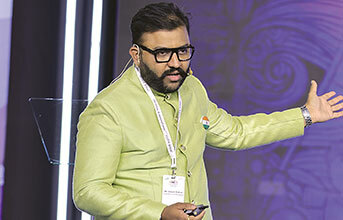
Over the years, the Indian government has introduced several initiatives to strengthen the manufacturing sector, including the Production Linked Incentive (PLI), National Infrastructure Pipeline (NIP), Supply Chain Resilience Initiative (SCRI), and PM Gati Shakti Scheme. These initiatives aim to increase the sector's contribution to GDP and position India as a global manufacturing hub.
Among these, the PLI scheme stands out as a transformative measure, offering strong financial support to entrepreneurs. "This is a game-changer for Indian manufacturing. Entrepreneurs can take risks knowing they have strong backing from the government," said Umesh Rathod. The model is being replicated across multiple industries, including semiconductor manufacturing. Additionally, initiatives under Startup India provide funding support to new ventures, promoting a robust ecosystem for innovation and entrepreneurship.
Infrastructure and regional development
The government's focus on infrastructure development has led to the expansion of industrial parks, special economic zones, and warehousing facilities. Maharashtra, for instance, is among the leading states in terms of industrial and warehousing land availability. Various regions across India have been earmarked for industrial and logistics hubs, further strengthening the country's manufacturing framework.
However, despite these advancements, there is room for further improvement. "India is in a race against time to capitalise on its young workforce. If we don't act now, we will lose our demographic advantage," Rathod emphasised. As India envisions a developed future under the Viksit Bharat 2047 initiative, it is essential to accelerate efforts now to leverage its demographic dividend, as the country currently has one of the youngest workforces globally.
Innovation and intellectual property: The key to competitiveness
India has made notable progress in global innovation rankings, particularly among middle-income economies. However, there is a pressing need to improve its intellectual property (IP) portfolio. A significant portion of global patents still originates from a few select countries, with India needing to boost its patent filings and commercialisation efforts.
"We need to change the way we view patents. Many innovations happening in our universities never see the light of day because they aren't patented or commercialised," Rathod pointed out. A key challenge lies in the academic approach to innovation— while numerous projects are developed within universities, many lack the right patent protections. Encouraging collaboration between industry and academia can bridge this gap, enabling companies to acquire and commercialise patents with strong business potential. Moreover, investing in industry-driven Ph.D. programmes, as seen in developed nations, can significantly enhance India's research output.
Leveraging traditional knowledge for global recognition
India's rich cultural heritage offers immense untapped potential in innovation. The example of global luxury brands using designs inspired by Indian traditions highlights the need to protect and commercialise indigenous knowledge. "Our ancient knowledge systems are being utilised by global brands, but we fail to recognise their value ourselves. This needs to change," Rathod stated.
Several foreign institutions study grassroots innovations in India. "They come here, learn from us, and commercialise it back home. We need to do this ourselves—protect, innovate, and scale," he added. To strengthen its position in global innovation, India must capitalise on its unique strengths, create intellectual property, and add value to the global market.
Future growth and emerging sectors
India is positioned to further solidify its standing as a global manufacturing hub. The country's industrial output is expanding across sectors such as textiles, electric vehicles, aerospace, and pharmaceuticals. Additionally, emerging industries like maritime business and aircraft maintenance, repair, and overhaul (MRO) present significant opportunities for investment and innovation.
looking at India as the next big manufacturing hub. We need to embrace innovation, invest in talent, and build a strong ecosystem for sustainable growth," Rathod said.
The key to sustained progress lies in fostering industry-academia collaboration, driving innovation, and strengthening the intellectual property framework. As global attention turns to India, the question remains: Are we ready to bet on ourselves?
With initiatives like Make in India and Atmanirbhar Bharat, the future of Indian manufacturing looks promising. To achieve self-reliance, progress, and global leadership, the nation must unite to manufacture success and shape the future of a stronger, more innovative India.


























